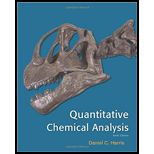
(a)
Interpretation:
For
Concept introduction:
Mean or average
Standard deviation (s):
Confidence interval: It can take any number of possibilities, with most common being 95% to 99%.
(a)
Answer to Problem 27.38P
Experiment: 1
95% confidence interval =
Experiment: 2
95% confidence interval =
Explanation of Solution
For experiment: 1
To find: mean for
To find: standard deviation for
- 1- Calculate the mean or average of given values.
- 2- For each number, subtract the average. Square the result
- 3- Adding all of the squared result
- 4- Divided this sum by (N-1)
Finally obtain the standard deviation for Chlorine is
To find: 95% confidence interval for
For experiment: 2
To find: mean for
To find: standard deviation for
- 1- Calculate the mean or average of given values.
- 2- For each number, subtract the average. Square the result
- 3- Adding all of the squared result
- 4- Divided this sum by (N-1)
Finally obtain the standard deviation for Chlorine is
To find: 95% confidence interval for
(b)
Interpretation:
There is any significant difference between given two experiments has to be predicted.
Concept introduction:
Mean or average
(b)
Answer to Problem 27.38P
There is no significant difference between two experiments.
Explanation of Solution
To explain: any significant difference between two experiments
So, there is no difference in significant. The result means addition of extra
(c)
Interpretation:
Expected mass of Barium sulphate has to be calculated if there is no coprecipitation.
(c)
Answer to Problem 27.38P
Mass of Barium sulphate is found to be
Explanation of Solution
To determine: Mass of Barium sulphate
(d)
Interpretation:
Average mass of precipitate in first experiment has to be calculated and the percentage is the mass greater than mass in part (c) has to be predicted.
(d)
Answer to Problem 27.38P
Average mass of Barium sulphate is found to be
Explanation of Solution
To determine: average mass of Barium chloride
In experiment 1, the precipitate include an extra
The increased mass is,
This is a large error in this experiment.
Want to see more full solutions like this?
Chapter 27 Solutions
Quantitative Chemical Analysis 9e & Sapling E-Book and Homework for Quantitative Chemical Analysis (Six Month Access) 9e
 ChemistryChemistryISBN:9781305957404Author:Steven S. Zumdahl, Susan A. Zumdahl, Donald J. DeCostePublisher:Cengage Learning
ChemistryChemistryISBN:9781305957404Author:Steven S. Zumdahl, Susan A. Zumdahl, Donald J. DeCostePublisher:Cengage Learning ChemistryChemistryISBN:9781259911156Author:Raymond Chang Dr., Jason Overby ProfessorPublisher:McGraw-Hill Education
ChemistryChemistryISBN:9781259911156Author:Raymond Chang Dr., Jason Overby ProfessorPublisher:McGraw-Hill Education Principles of Instrumental AnalysisChemistryISBN:9781305577213Author:Douglas A. Skoog, F. James Holler, Stanley R. CrouchPublisher:Cengage Learning
Principles of Instrumental AnalysisChemistryISBN:9781305577213Author:Douglas A. Skoog, F. James Holler, Stanley R. CrouchPublisher:Cengage Learning Organic ChemistryChemistryISBN:9780078021558Author:Janice Gorzynski Smith Dr.Publisher:McGraw-Hill Education
Organic ChemistryChemistryISBN:9780078021558Author:Janice Gorzynski Smith Dr.Publisher:McGraw-Hill Education Chemistry: Principles and ReactionsChemistryISBN:9781305079373Author:William L. Masterton, Cecile N. HurleyPublisher:Cengage Learning
Chemistry: Principles and ReactionsChemistryISBN:9781305079373Author:William L. Masterton, Cecile N. HurleyPublisher:Cengage Learning Elementary Principles of Chemical Processes, Bind...ChemistryISBN:9781118431221Author:Richard M. Felder, Ronald W. Rousseau, Lisa G. BullardPublisher:WILEY
Elementary Principles of Chemical Processes, Bind...ChemistryISBN:9781118431221Author:Richard M. Felder, Ronald W. Rousseau, Lisa G. BullardPublisher:WILEY





